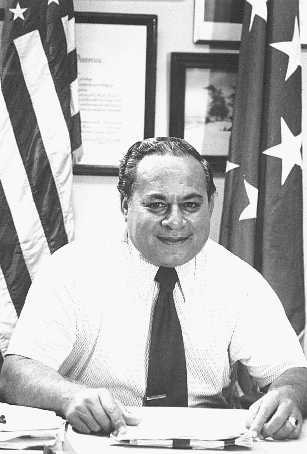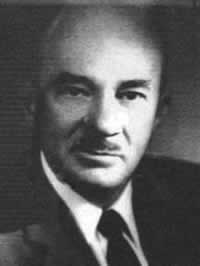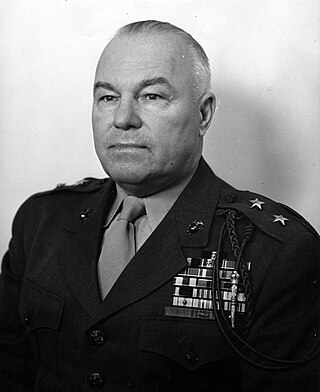
German Samoa was a German protectorate from 1900 to 1920,consisting of the islands of Upolu,Savai'i,Apolima and Manono,now wholly within the Independent State of Samoa,formerly Western Samoa. Samoa was the last German colonial acquisition in the Pacific basin,received following the Tripartite Convention signed at Washington on 2 December 1899 with ratifications exchanged on 16 February 1900. It was the only German colony in the Pacific,aside from the Jiaozhou Bay Leased Territory in China,that was administered separately from German New Guinea.

The Navy Cross is the United States Naval Service's second-highest military decoration awarded for Sailors and Marines who distinguish themselves for extraordinary heroism in combat with an armed enemy force. The medal is equivalent to the Army's Distinguished Service Cross,the Air and Space Forces' Air Force Cross,and the Coast Guard Cross.

Peter Tali Coleman was an American Samoan politician and lawyer. Coleman was the first and only person of Samoan descent to be appointed governor of American Samoa between 1956 and 1961 and later became the territory's first and third popularly elected governor from 1978 to 1985 and 1989 to 1993,serving a total of three elected terms. In between,he had served in different administrative positions for Pacific islands.

Henry Clay Ide was a U.S. judge,colonial commissioner,ambassador,and Governor-General of the Philippines.
Coe is a surname of English origin. At the time of the British Census of 1881,its frequency was highest in Northamptonshire,followed by Norfolk,Cambridgeshire,Suffolk,Essex,Leicestershire,Huntingdonshire,Surrey,London and Kent. Notable people with the surname include:
In the United States,a governor serves as the chief executive and commander-in-chief in each of the fifty states and in the five permanently inhabited territories,functioning as head of state and head of government therein. While like all officials in the United States,checks and balances are placed on the office the governor,significant powers may include,ceremonial head of state,executive,legislative,judicial,and military. As such,governors are responsible for implementing state laws and overseeing the operation of the state executive branch. As state leaders,governors advance and pursue new and revised policies and programs using a variety of tools,among them executive orders,executive budgets,and legislative proposals and vetoes. Governors carry out their management and leadership responsibilities and objectives with the support and assistance of department and agency heads,many of whom they are empowered to appoint. A majority of governors have the authority to appoint state court judges as well,in most cases from a list of names submitted by a nominations committee.

James Sutherland Spore was a commander in the United States Navy. He served as acting governor of Guam from February 27,1921 to February 7,1922 and as acting governor of American Samoa from March 24,1931 to April 22,1931.

Richard Barrett Lowe was the governor of American Samoa and the eighth American governor of Guam. He was also a prominent educator and United Nations observer.
William Coe may refer to:
William Elbridge Sewell was a United States Navy Lieutenant Commander and the 6th Naval Governor of Guam from February 9,1903,until he returned to the mainland United States for medical treatment on January 11,1904. He was born in Colchester,New York,and appointed to the United States Naval Academy from that state in 1867. He served on numerous ships before becoming an ensign,and eventually became executive officer or commanding officer of a series of ships and installations. He then became commanding officer of the Guam flagship,and soon after,governor of Guam. As governor,he initiated a series of tax and legal reforms,including many that restored the rights of the native population to practice their culture more freely. He legalized and taxed alcohol and set up a court system that lasted 30 years. In January 1904,he fell ill from intestinal troubles and was transported to California for treatment,where he died while still in office.
George Robert Salisbury was a United States Navy Commodore who served as the 15th Naval Governor of Guam. Though he originally served as an Engineering Duty Officer,he eventually stopped being a Restricted Line Officer,and retired from the Navy as a Commodore. As governor,he rolled back a number of educational reforms and encouraged a new ranch system. He also took drastic measures to control the leprosy epidemic on the island,removing the infected to Philippines. He was briefly called into service during World War I before retiring.

Alfred Walton Hinds was a United States Navy captain who served as the 17th Naval Governor of Guam. His early naval service included serving as Assistant Engineer aboard USS Texas,the United States Navy's first battleship,where he was reprimanded for an accident aboard in 1896. In 1911,Hinds joined the staff of the United States Naval Academy,heading the Department of Marine Engineering and Naval Construction,writing a textbook on the subject while there.

Adelbert Althouse was a United States Navy Captain who served as the 27th and 29th Naval Governor of Guam. Prior to his Governorship,he served on ships in the Navy and participated in both the Spanish–American War and World War I. He earned the Navy Cross for his actions commanding USS Brooklyn and serving as Chief of Staff for the Commander and Chief of the United States Asiatic Fleet during the World War. As Governor,he focused on reforming the island's education system. He modeled a new system after that of co-educational California but also outlawed the speaking of the Chamorro language at schools in an effort to improve the English language skills of the local children. Most of his education reform took place in his first term.
Lloyd Stowell Shapley was a United States Navy Captain who served as the 32nd Naval Governor of Guam. Shapley served as governor from April 7,1926,to June 11,1929.
Ivan Cyrus Wettengel was a United States Navy captain who served as the 25th Naval Governor of Guam. A graduate of the United States Naval Academy,Wettengel commanded a number of ships. He received the Navy Cross for his command of USS Wisconsin during World War I. He also commanded USS Texas and the Naval Training Station Hampton Roads. During his tenure as governor,he overturned many of the unpopular policies of William Gilmer. He also attempted to assemble a bull-mounted Guam Cavalry,but the initiative failed. A number of locations in Guam are named in his honor.

Lieutenant General Henry Louis Larsen was a United States Marine Corps officer,the second Military Governor of Guam following its recapture from the Empire of Japan,and the first post-World War II Governor of Guam. He also served as the Military Governor of American Samoa alongside civilian Governor of American Samoa Laurence Wild. Larsen was among the first troops overseas in both World Wars. During World War I,he commanded the 3rd Battalion 5th Marines and participated in numerous battles in France,earning the Navy Cross,three Silver Stars,the Croix de guerre with palm,and the French Legion of Honour. In between the World Wars,he served during the United States occupation of Nicaragua,where he earned his second Navy Cross,the Presidential Medal of Merit from President of Nicaragua JoséMaría Moncada Tapia,and his first Navy Distinguished Service Medal.

American Samoa consists of a group of two coral atolls and five volcanic islands in the South Pacific Ocean of Oceania. The first permanent European settlement was founded in 1830 by British missionaries,who were followed by explorers from the United States,in 1839,and German traders in 1845. Based upon the Tripartite Convention of 1899,the United States,Great Britain,and Germany agreed to partition the islands into German Samoa and American Samoa. Though the territory was ceded to the United States in a series of transactions in 1900,1904,and 1925,Congress did not formally confirm its acquisition until 1929. American Samoans are non-citizen nationals of the United States. Non-citizen nationals do not have full protection of their rights,though they may reside in the United States and gain entry without a visa. Territorial citizens do not have the ability for full participation in national politics and American Samoans cannot serve as officers in the US military or in many federal jobs,are unable to bear arms,vote in local elections,or hold public office or civil-service positions even when residing in a US state. Nationality is the legal means in which inhabitants acquire formal membership in a nation without regard to its governance type. Citizenship is the relationship between the government and the governed,the rights and obligations that each owes the other,once one has become a member of a nation.
Guam is an island in the Marianas archipelago of the Northern Pacific located between Japan and New Guinea on a north–south axis and Hawaii and the Philippines on an east–west axis. Inhabitants were Spanish nationals from 1521 until the Spanish–American War of 1898,from which point they derived their nationality from United States law. Nationality is the legal means in which inhabitants acquire formal membership in a nation without regard to its governance type. In addition to being United States nationals,people born in Guam are both citizens of the United States and citizens of Guam. Citizenship is the relationship between the government and the governed,the rights and obligations that each owes the other,once one has become a member of a nation. Though the Constitution of the United States recognizes both national and state citizenship as a means of accessing rights,Guam's history as a territory has created both confusion over the status of its nationals and citizenship and controversy because of distinctions between jurisdictions of the United States.











